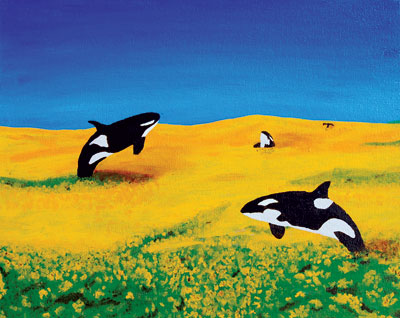All Nonfiction
- Bullying
- Books
- Academic
- Author Interviews
- Celebrity interviews
- College Articles
- College Essays
- Educator of the Year
- Heroes
- Interviews
- Memoir
- Personal Experience
- Sports
- Travel & Culture
All Opinions
- Bullying
- Current Events / Politics
- Discrimination
- Drugs / Alcohol / Smoking
- Entertainment / Celebrities
- Environment
- Love / Relationships
- Movies / Music / TV
- Pop Culture / Trends
- School / College
- Social Issues / Civics
- Spirituality / Religion
- Sports / Hobbies
All Hot Topics
- Bullying
- Community Service
- Environment
- Health
- Letters to the Editor
- Pride & Prejudice
- What Matters
- Back
Summer Guide
- Program Links
- Program Reviews
- Back
College Guide
- College Links
- College Reviews
- College Essays
- College Articles
- Back
Why We Must Set SeaWorld Orcas Free
For over six decades, the SeaWorld organization has grown into the world’s best known marine park for its many attractions, with killer whales being the most popular. However, animal activists in recent years have brought negative attention upon SeaWorld’s beloved animals and parks. The 2013 film “Blackfish” by Gabriela Cowperthwaite focused on the marine park’s “flaws” and called them out on their lack of responsibility regarding the orcas, which resulted in dozens of injuries involving trainers who worked closely with them, as well as accusing SeaWorld of other illegal activities. What the film is most famous for is its controversial topic of whether life in captivity affects the lives and life span of the orcas. The question of whether it is acceptable and humane for living creatures to live a life in captivity is debated when research and educated opinions from scientists have proven that it truly does affect the lifespan of orcas is asked, but comes with few answers.
The film showed the way orcas are separated from their families and clan to be taken into captivity. Once the orcas arrive to park, they have an extremely limited space to swim in and cannot swim freely in the same amount that they should and would in the ocean. In the article “Jane Goodall Says ‘SeaWorld Should Be Closed Down’” by Alexander C. Kaufman, he discusses the cruelty that orcas living in SeaWorld parks face inside the restricted tanks. Well-known scientist and animal advocate Jane Goodall explains that vocal waves orcas use to communicate with each other “echo back” inside tanks and, “create a hellish cacophony for the animals”(Goodall 4). A SeaWorld spokesperson argued that tanks were “specially crafted to keep underwater noise levels quieter than the ambient ocean,”(Kaufman 9). “Blackfish” on the other hand spoke of the already existing difficulties that orcas had when they wanted to communicate but cannot due to the different sounds each clan of whales make. Orcas are not only unable to communicate with their peers, but also have to withstand the disturbing and chaotic echoes of their own unheard voice.
Orcas often got injured because of equipment and a few of their massively popular performances ended in fatal injuries to the trainers. Whether the orcas hurt their trainers because they were too playful or became angry is still in question, however, these animals are not meant provide entertainment. As seen, orcas can definitely be trained to understand and act on command, but should they? No animal in the world would want or appreciate spending its life only to be used entertainment to a crowd of people when it can result in their pain. As a way to punish the whales for misbehaving during training, trainers would go as far as to starve them until they followed directions. Not allowing an animal in captivity the right to eat because they cannot provide or perform something they were not born to do or understand is unacceptable.
One might presumably think SeaWorld animals living in captivity would live better and healthier lives than the free orcas in the ocean, but orcas living in captivity live an average of thirty-five years when they could live up to at least double that amount. Similar information that is heard in the film, Kaufman talks of SeaWorld’s death rate among orcas and that, “at least 160 orcas have died in captivity since 1961,” with an appalling “30 pregnant whales that have miscarried or had stillborn calves,”(Kaufman 10). If orcas in the wild can expect to live an average of 60-70 years, it is undoubtedly questionable as to why so many have died in what would be one whale’s life time. Without their freedom, orcas face a life of isolation because they are kept with whales that are not from the same clan and can therefore not understand each other. The only other kind of interaction they receive is from trainers and visitors which is clearly not the best for their health.
Although it was proven that SeaWorld captured their orcas over forty years ago and has not done so again since, such vast and unique creatures should not have to live their lives in confinement. Just like any animal, being taken away from their natural habitat will only cause them harm, whether it be physical or emotional. One or both, they damage the health of an animal that could have had a long life ahead of them.
Works Cited
"About Jane - The Jane Goodall Institute." The Jane Goodall Institute. N.p., n.d. Web. 28 Oct. 2015.
Blackfish. Dir. Gabriela Cowperthwaite. Sundance: Magnolia Pictures, 2013. Film.
Kaufman, Alexander C. "Jane Goodall Says SeaWorld 'Should Be Closed Down'" The Huffington Post. TheHuffingtonPost.com, 27 Apr. 2015. Web. 28 Oct. 2015.

Similar Articles
JOIN THE DISCUSSION
This article has 0 comments.

I would like to consider myself an animal rights advocate and would love doing more to help stop animal cruelty, testing, abuse, and close harmful zoos, and marine parks